Pissaladière is a flatbread from Nice topped with anchovies and black olives. The crisp and fluffy crust supports a thick layer of caramelized onions slow-cooked with herbs until they’re meltingly tender and golden brown.
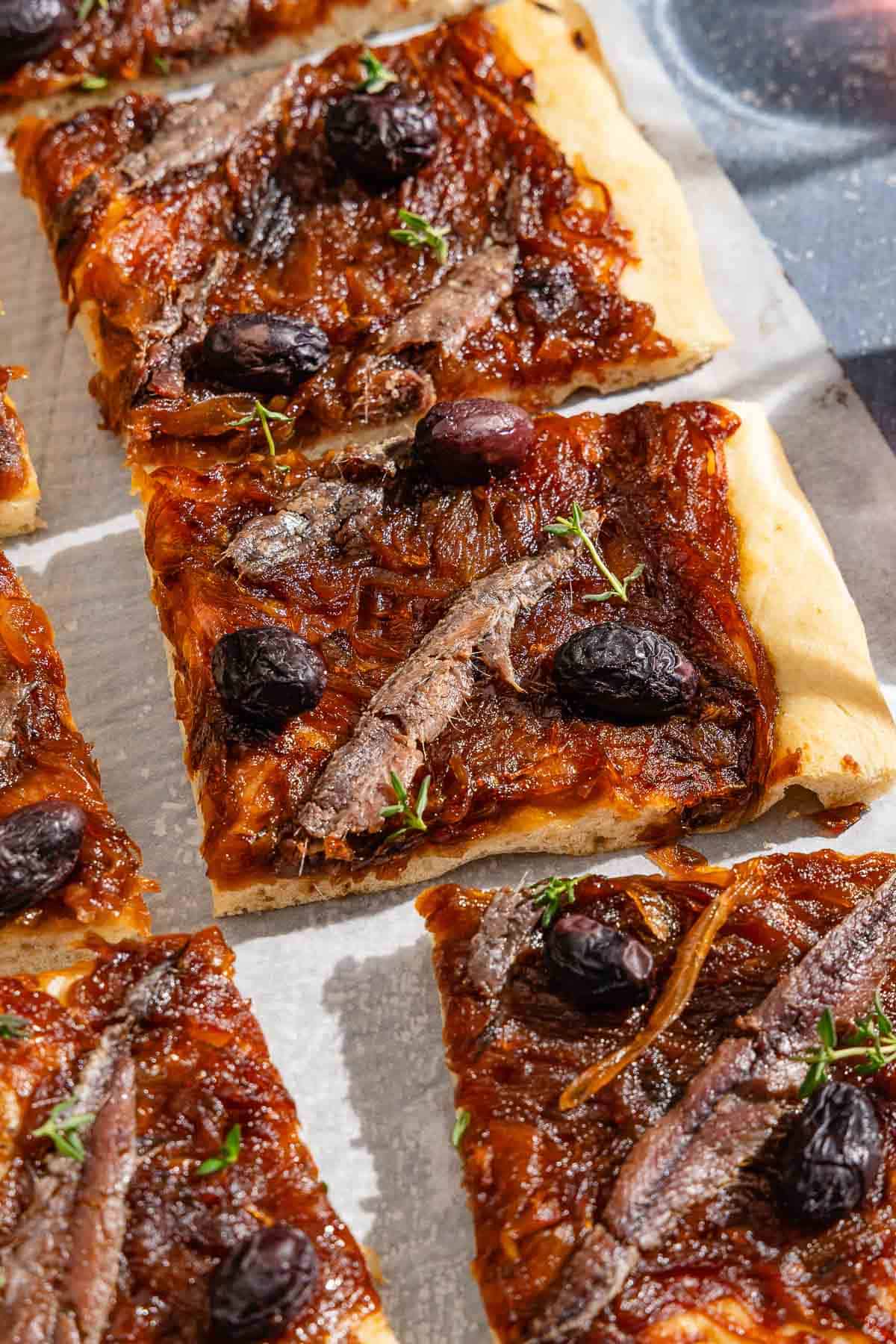
This savory onion tart, known as Pissaladière, is sometimes made with a shortcrust or puff pastry base, but a bread dough is the most traditional.
I find that richer shortcrust and puff pastry can make the tart feel heavy or greasy, especially when smothered with so many caramelized onions. The lean, soft dough of the flatbread in this pissaladiere recipe balances the intense flavors of the toppings.
It’s a lovely recipe to make for a light weekend lunch with friends. Serve it with fresh salad and something crisp and refreshing to drink like a perfectly chilled glass of rosé.
Table of Contents
What is Pissaladière?
Pissaladière (which is pronounced pee-sah-lah-di-air) is a savory tart or flatbread from the coastal city of Nice in Provence, which sits on the Southern coast of France.
The name comes from the Provençal word pissala, a salted anchovy pâté that would have at one time been spread directly over the dough with the onions. Now, it’s typically topped with a layer of caramelized onions and then topped with oil-cured anchovy fillets, sometimes arranged in a diamond pattern, with Nicoise olives in the center of each square.
Pissaladière has roots that stretch back centuries and reflects the influence of nearby Italy. If this pissaladière recipe resembles a pizza, it’s because Nice is only 20 miles from the Italian border, and it was part of neighboring Piedmont until as recently as 1860.
But you won’t typically find tomato sauce or cheese on a classic pissaladière. In nearby Liguria, you’ll find sardenaira, a similar flatbread without cheese. That version typically includes tomato, a cousin to Sicily’s Sfincione.
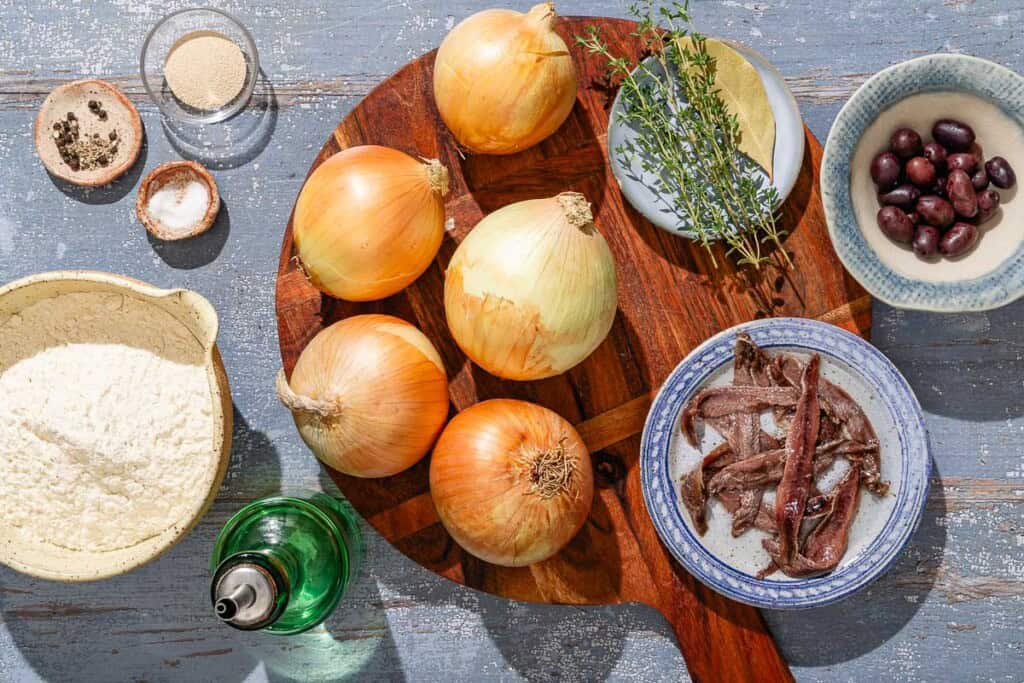
Ingredients for Pissaladière
The salty-sweet trio of caramelized onions, anchovies, and black olives do all the heavy lifting in this delicious flatbread. For such intense flavor, pissaladière has a surprisingly short list of ingredients, with the added benefit that most of them are long-keeping pantry cupboard staples. Here’s what you’ll need:
For the Dough
- All-purpose flour: The moderate protein content in all-purpose flour makes a light, fluffy dough.
- Instant yeast: Since it doesn’t need to bloom before adding to the dough, instant yeast is a lot more convenient. My favorite is Saf Red Instant Yeast, but not to worry—the recipe includes instructions for using active dry yeast if that’s what you have on hand.
- Kosher salt: Salt enhances the flavor of the tart and also helps to draw out the water from the onions for better caramelization.
- Extra virgin olive oil: Olive oil adds richness and a fluffy texture to the dough and also helps the onions soften. For this tart, I prefer a mild and buttery olive oil, such as Arbequina.
For the Topping
- Yellow onions: For caramelizing, yellow onions strike a nice balance between sweetness and intensity of flavor. You can substitute sweet onions, but they will be milder in flavor.
- Fresh thyme infuses the onions with a woodsy aroma while they caramelize. You can mix it up with rosemary or a mix of woody-stemmed herbs.
- Bay leaf adds complexity and depth of flavor to the caramelized onions.
- Anchovy fillets: Oil-packed anchovy fillets pack a punch of salty, umami flavor. For this tart you’ll want oil-cured anchovies (the ones sold jarred or canned) rather than boquerones.
- Black olives: Tiny and briny Niçoise olives are the classic choice for pissaladière, but you can substitute another type of black olives, including Kalamata. Choosing pitted olives makes pissaladiere far easier to eat.
How to Make Pissaladière
Caramelizing the onions while the dough rises reduces the overall time it takes to put this pissaladiere recipe together, but plan on about 2 1/2 hours before the tart is ready to serve. Here are the steps:
- Mix the dough: In a large mixing bowl, or in the bowl of a stand mixer fitted with the dough hook attachment, combine 2 cups (250g) all-purpose flour, 1 teaspoon instant yeast, and 1 teaspoon kosher salt. Pour in 2/3 cup (160ml) warm water (80-90°F), and 2 tablespoons extra virgin olive oil, and mix until the dough comes together into a ball and all of the flour is moistened.
- Knead the dough: Knead on speed 2 for 4 minutes, or until the dough is elastic and mostly smooth. If working by hand, turn the dough out onto a lightly floured work surface. Knead by hand for 5 minutes. If the dough is too sticky to work with, sprinkle it with 1 teaspoon of flour at a time as you knead it to achieve a soft, slightly tacky consistency. Do not add more flour than necessary, as the dough will become too dry.
- Let the dough rise: Lightly grease the bowl with olive oil and turn the ball of dough to coat it lightly. Cover the bowl and let the dough rise in a warm place for about 1 hour, or until the dough has roughly doubled in volume.
- Caramelize the onions: While the dough is rising, caramelize the onions. In a large skillet or Dutch oven with a lid, combine 3 pounds (1.36 kg) thinly sliced onions, 3/4 cup (180ml) water, 2 tablespoons extra virgin olive oil, 3/4 teaspoon kosher salt, a small handful of fresh thyme sprigs, and 1 bay leaf. Bring to a boil over high heat. Cover and cook until the water has evaporated, about 10 minutes. Uncover and continue to cook, stirring often, until the onions are softened and golden brown, about 15 to 20 minutes. If the onions stick to the pan, loosen them with a splash of water. Remove from the heat. Discard the thyme stems and bay leaf. Set aside to cool slightly until the dough is ready.
- Preheat the oven: Preheat the oven to 400°F. Line a rimmed half-sheet pan with parchment paper.
- Assemble the tart: Turn the dough out onto the prepared pan. With your hands, stretch the dough into a rectangle just about to the edges of the pan. It should be approximately 1/4 to 1/2 inch thick. Let it rest for 15 minutes. Let it rest for 15 minutes. Spread the caramelized onions over the dough, leaving a thin border around the edge. Lay about 12 anchovy filets over the top and dot with 1/4 cup pitted black olives. Brush the edges lightly with olive oil.
- Bake: Bake for 20 to 25 minutes, or until the crust is lightly browned. Remove the tart from the oven and transfer it to a cooling rack.
- Serve: Cut into squares and serve warm or at room temperature. The tart is best the day it is baked.
How to Caramelize Onions
Caramelizing onions properly is a labor of love, taking upwards of 45 minutes to an hour. But my favorite method slashes the time and effort by softening the onions first with water in a lidded pot. After 10 minutes of hands-off simmering, the onions will have fast-forwarded to a meltingly tender stage. Now, just continue cooking them uncovered until they reach your desired level of caramelization.
To prevent the onions from sticking to the pan, stir them occasionally, every minute or so, which will also help them to caramelize evenly. If they’re really stuck, or the fond is getting too dark, add a splash of water to the pan. The more often you do this, however, the longer it will take to caramelize the sugar in the onions.
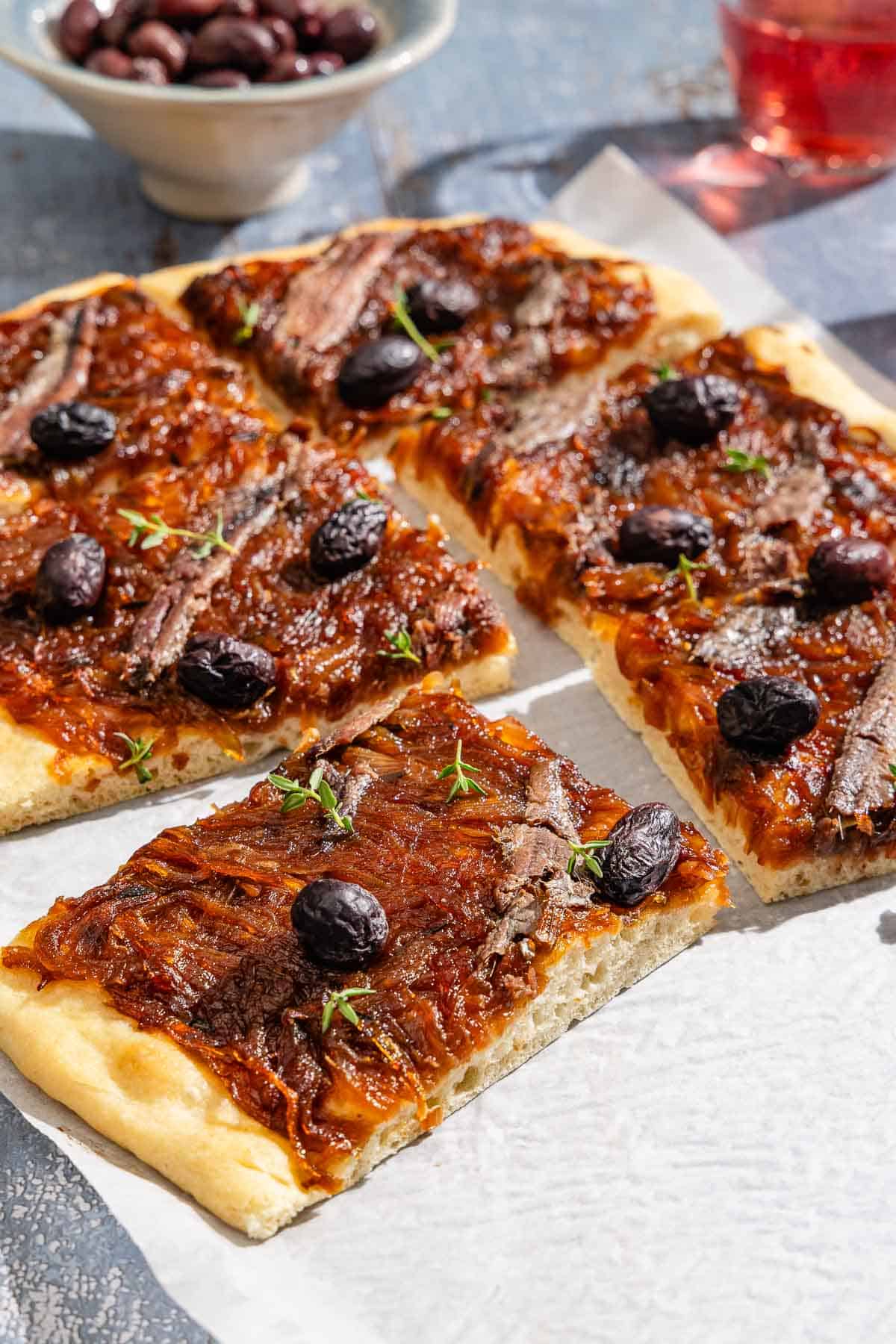
Make It Your Own
Pissaladière is traditionally simple, topped with just caramelized onion, anchovies, and Niçoise olives. But that shouldn’t stop you from experimenting. Here are some ideas to get you started:
- Add tomatoes: Dot the tart with some roughly chopped sun-dried tomatoes or halved cherry tomatoes (skin-side down to avoid a soggy crust) before baking.
- Roasted red peppers: Arrange thinly sliced roasted bell peppers over the tart before baking.
- Roasted garlic: Add some sweet, intensely flavored roasted garlic cloves to the tart before baking.
- Swap the olives: Instead of Niçoise olives, try other black or even green olives. Scatter some capers over the tart. Or use a briny mix of your favorites. You could also swizzle on some olive tapenade instead.
- Take a shortcut: Substitute store-bought pizza dough instead of making your own. Be sure to let it come to room temperature before trying to stretch it out.

What to Serve With Pissaladière
Serve pissaladière as a light lunch paired with a simple salad, such as this lemon parmesan salad. The bright lemon dressing provides a tangy contrast to the rich flavors of the tart. It would also be right at home next to some roasted artichoke hearts or grilled artichokes with garlic, parsley, and lemon.
Pissaladière makes a fancy appetizer for a dinner party. Make a large Niçoise salad, or simple poached salmon with a green bean salad for the main course. In Provence, it’d be hard to find pissaladière without some rosé wine nearby. To elevate it, use a bottle for a batch of refreshing rosé lemonade.
More Mediterranean Flatbreads
Mediterranean Diet Recipes
Greek-Style Flatbread Pizza
Middle Eastern
Musakhan: Sumac Chicken and Caramelized Onion Flatbread
Browse all Mediterranean recipes.
Visit Our Shop.
Pissaladière

Ingredients
For the Dough
- 2 cups all-purpose flour (250g)
- 1 teaspoon instant yeast
- 1 teaspoon kosher salt
- 2/3 cup warm water (80-90°F) (160ml)
- 2 tablespoons extra virgin olive oil
For the Topping
- 3 pounds yellow onions, thinly sliced (1.36kg)
- 3/4 cup water (180ml)
- 2 tablespoons extra virgin olive oil
- 3/4 teaspoon kosher salt
- Fresh thyme
- 1 bay leaf
- 12 oil-cured anchovy filets (canned or jarred)
- 1/4 cup Kalamata olives, pitted
Instructions
- Mix the dough. In a large mixing bowl, or in the bowl of a stand mixer fitted with the dough hook attachment, combine the flour, yeast, and salt. Pour in the water and olive oil, and mix until the dough comes together into a ball and all of the flour is moistened.
- Knead the dough. Knead on speed 2 for 4 minutes, or until the dough is elastic and mostly smooth. If working by hand, turn the dough out onto a lightly floured work surface. Knead by hand for 5 minutes. If the dough is too sticky to work with, sprinkle it with 1 teaspoon of flour at a time as you knead it to achieve a soft, slightly tacky consistency. Do not add more flour than necessary, as the dough will become too dry.
- Let the dough rise. Lightly grease the bowl with olive oil and turn the ball of dough to coat it lightly. Cover the bowl and let the dough rise in a warm place for about 1 hour, or until the dough has roughly doubled in volume.
- Caramelize the onions. While the dough is rising, caramelize the onions. In a large skillet or Dutch oven with a lid, combine the onions, water, olive oil, salt, thyme, and bay leaf. Bring to a boil over high heat. Cover and cook until the water has evaporated, about 10 minutes. Uncover, and continue to cook, stirring often, until the onions are softened and golden brown, about 15 to 20 minutes. If the onions stick to the pan, loosen them with a splash of water. Remove from the heat. Discard the thyme stems and bay leaf. Set aside to cool slightly until the dough is ready.
- Preheat the oven. Preheat the oven to 400°F. Line a rimmed half-sheet pan with parchment paper.
- Assemble the tart. Turn the dough out onto the prepared pan. With your hands, stretch the dough into a rectangle just about to the edges of the pan. It should be approximately 1/4 to 1/2 inch thick. Let it rest for 15 minutes. Spread the caramelized onions over the dough, leaving a thin border around the edge. Lay the anchovies over the top and dot with the olives. Brush the edges lightly with olive oil.
- Bake. Bake for 20 to 25 minutes, until the crust is lightly browned. Remove the tart from the oven and transfer it to a cooling rack.
- Serve. Cut into squares and serve warm or at room temperature. The tart is best the day it is baked.
Notes
- Shop this recipe: Visit our shop to browse quality Mediterranean ingredients including the olive oil and olives used in this recipe.
- To use active dry yeast in place of instant yeast, increase the amount to 1 1/4 teaspoon. Dissolve the yeast in 1/3 cup of the warm water and let it bloom for 5 minutes until frothy. Then add the rest of the dough ingredients and continue with step 1 of the recipe.
Nutrition

Bundle and Save!
Bring the authentic flavors of Greece to your table with Greek Kalamata Olives and Green Chalkidiki Olives Stuffed with Lemon.


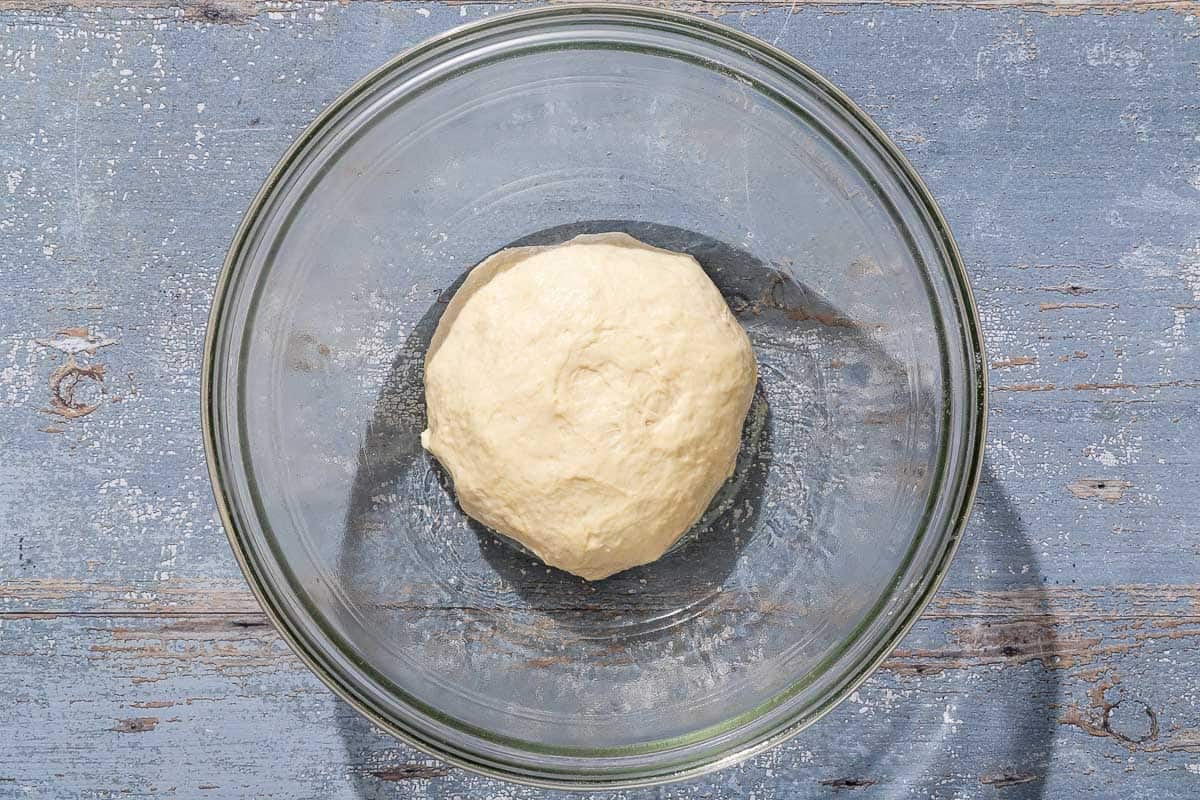
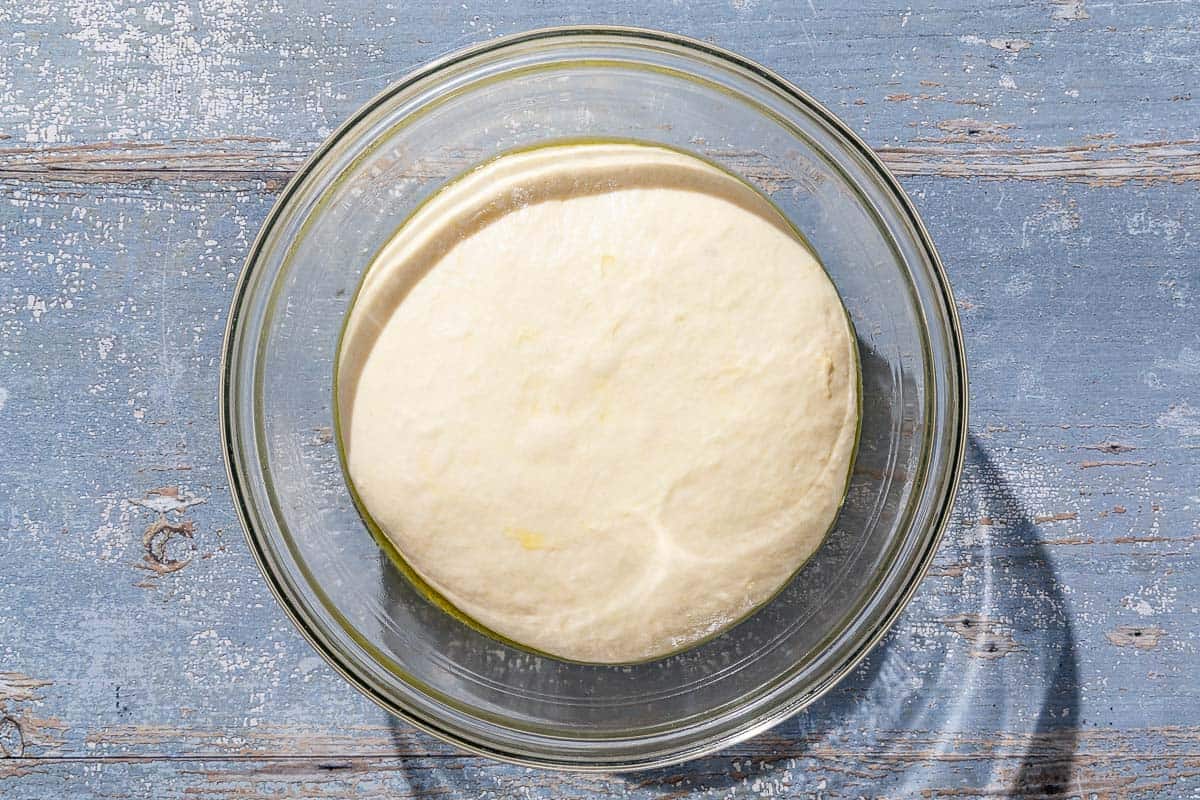
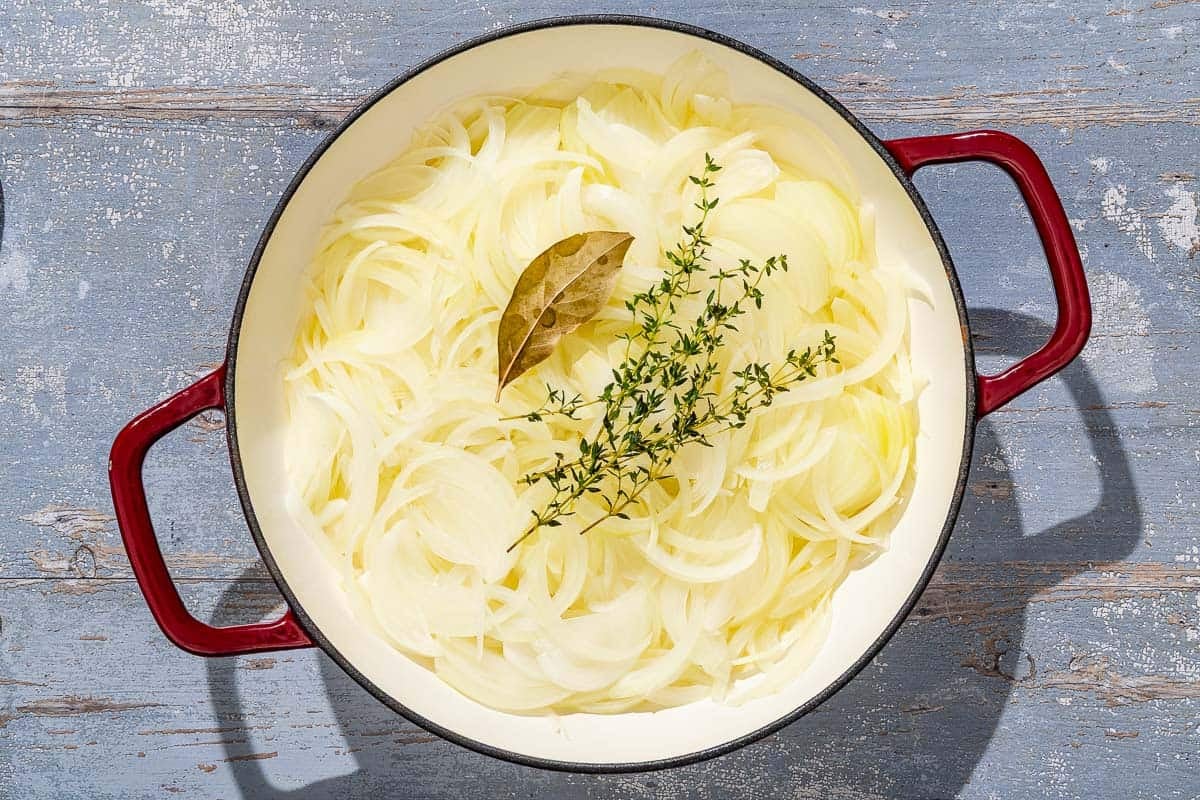
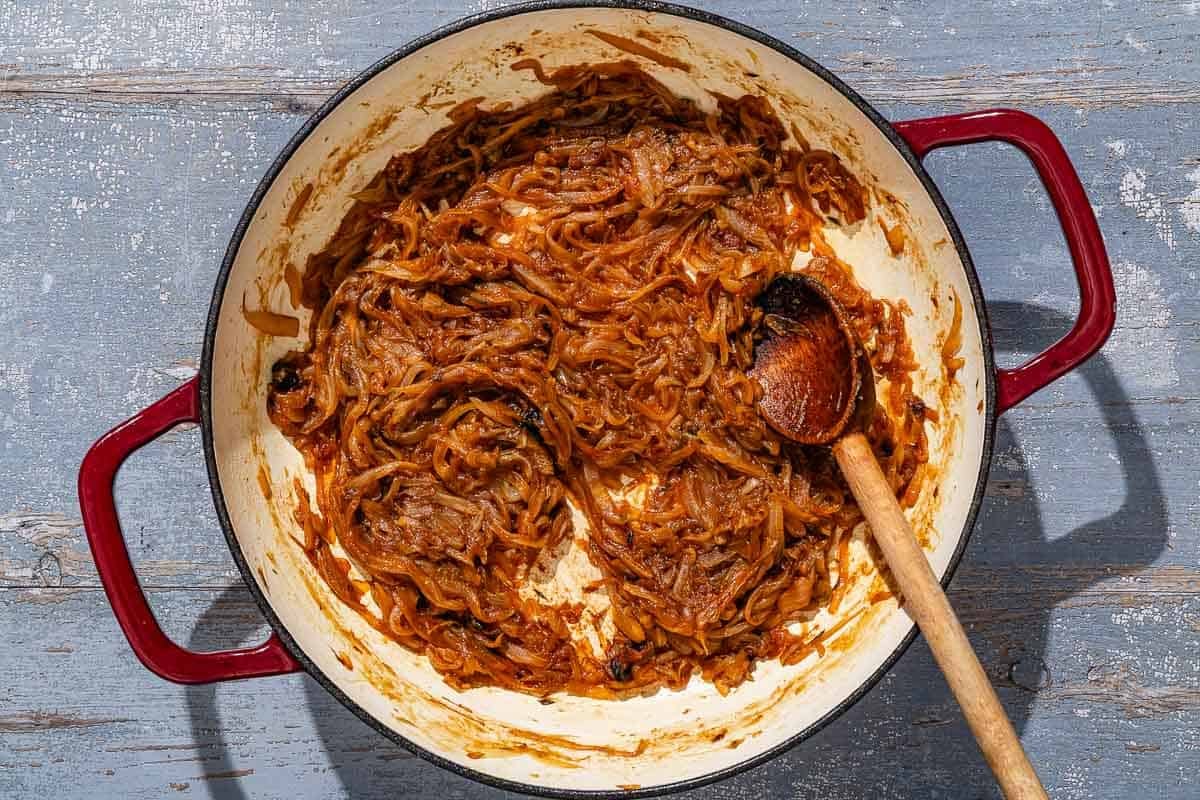
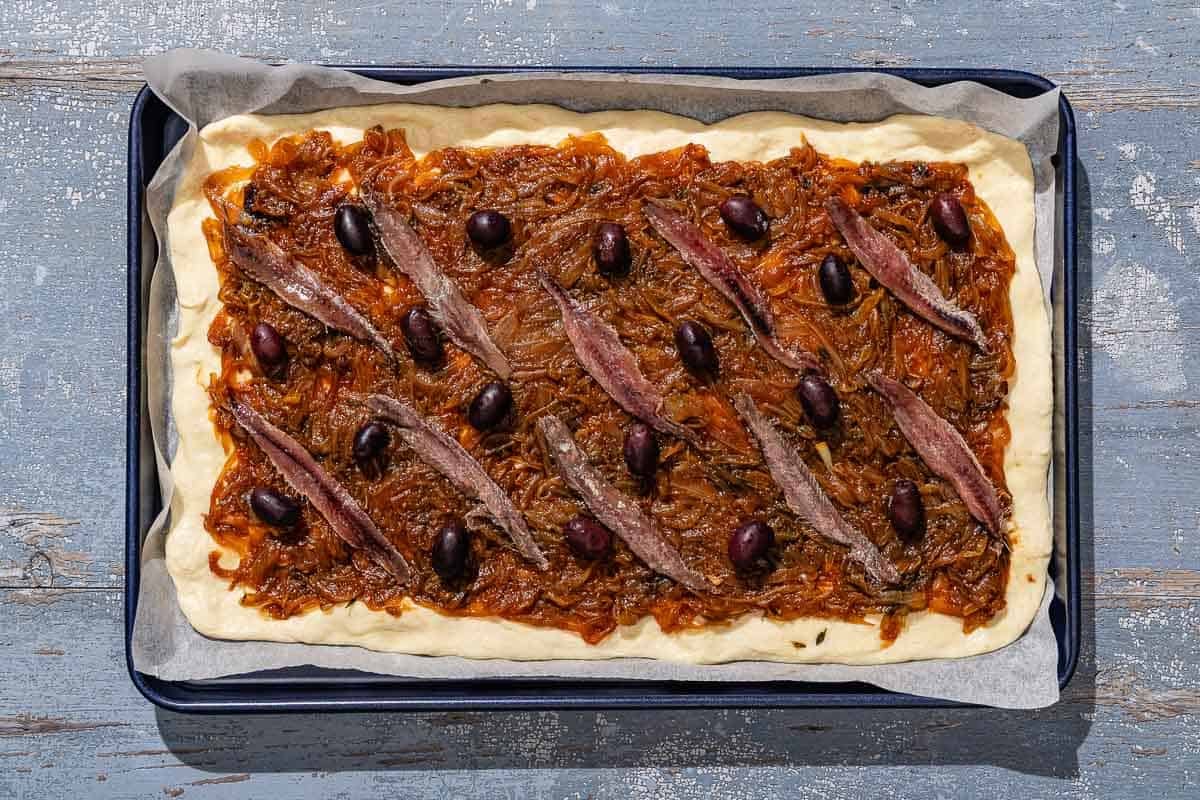
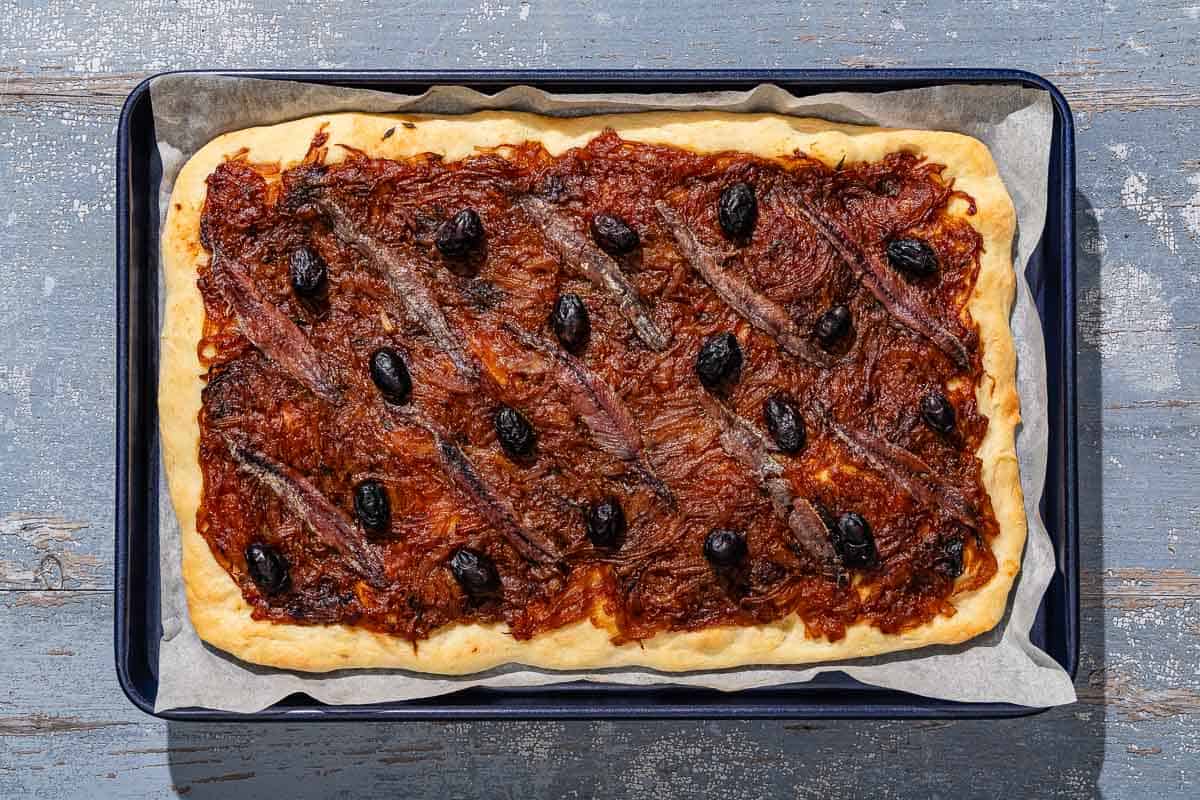

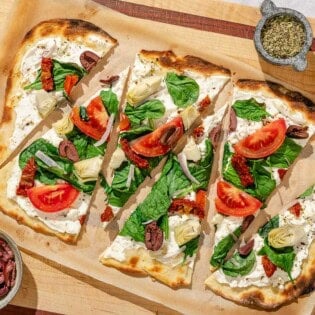


Love the balance of flavors in this one!
Easy to make,I used flat bread as a base and without an oven I used my microwave and it turned out perfectly